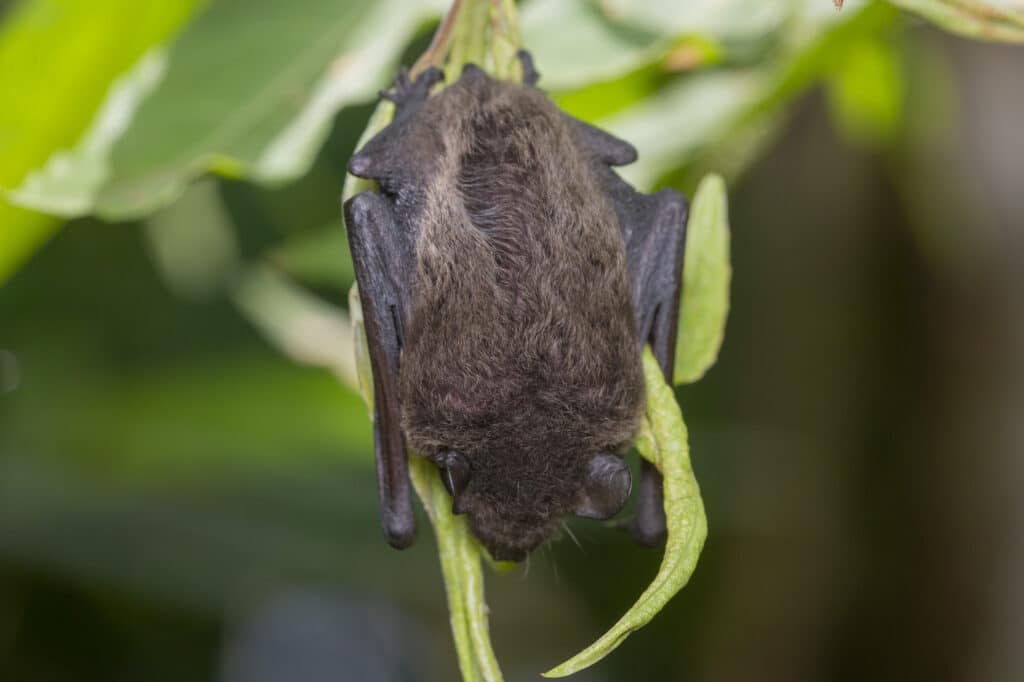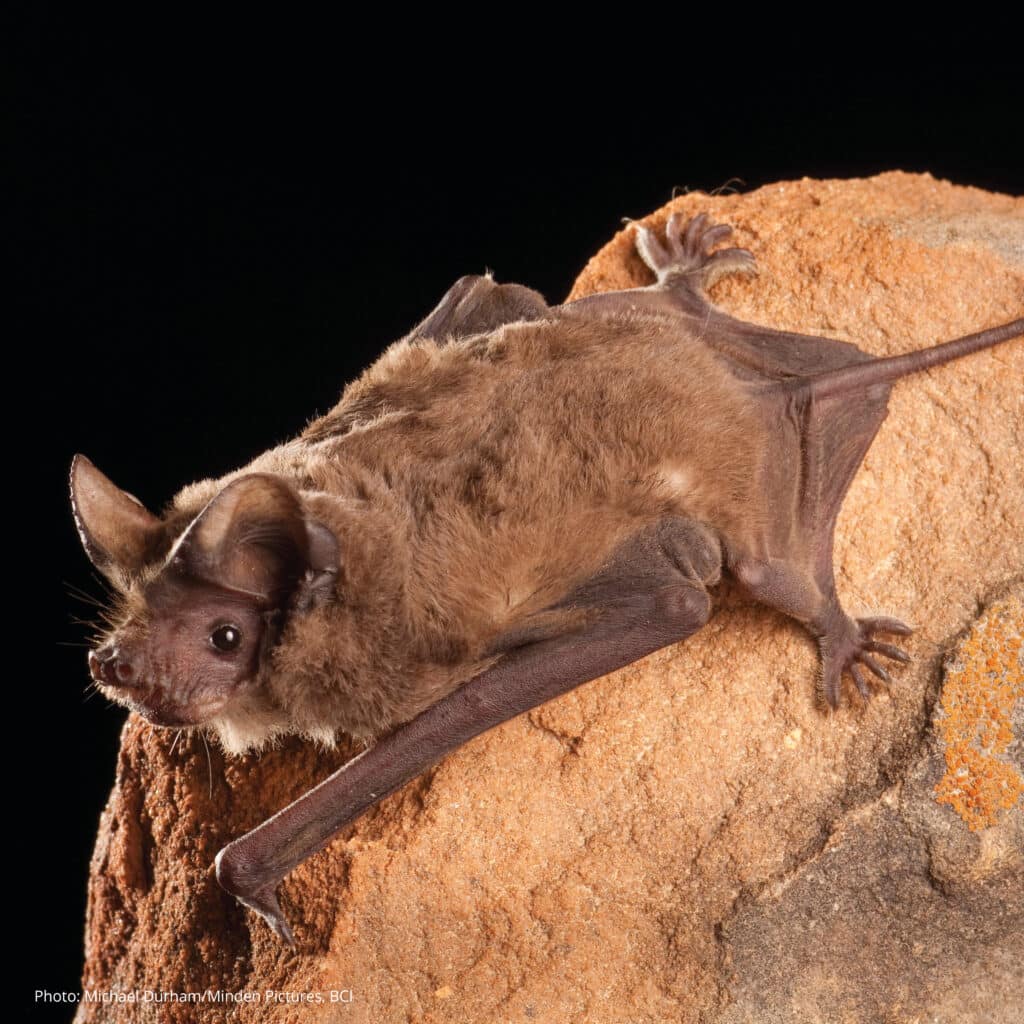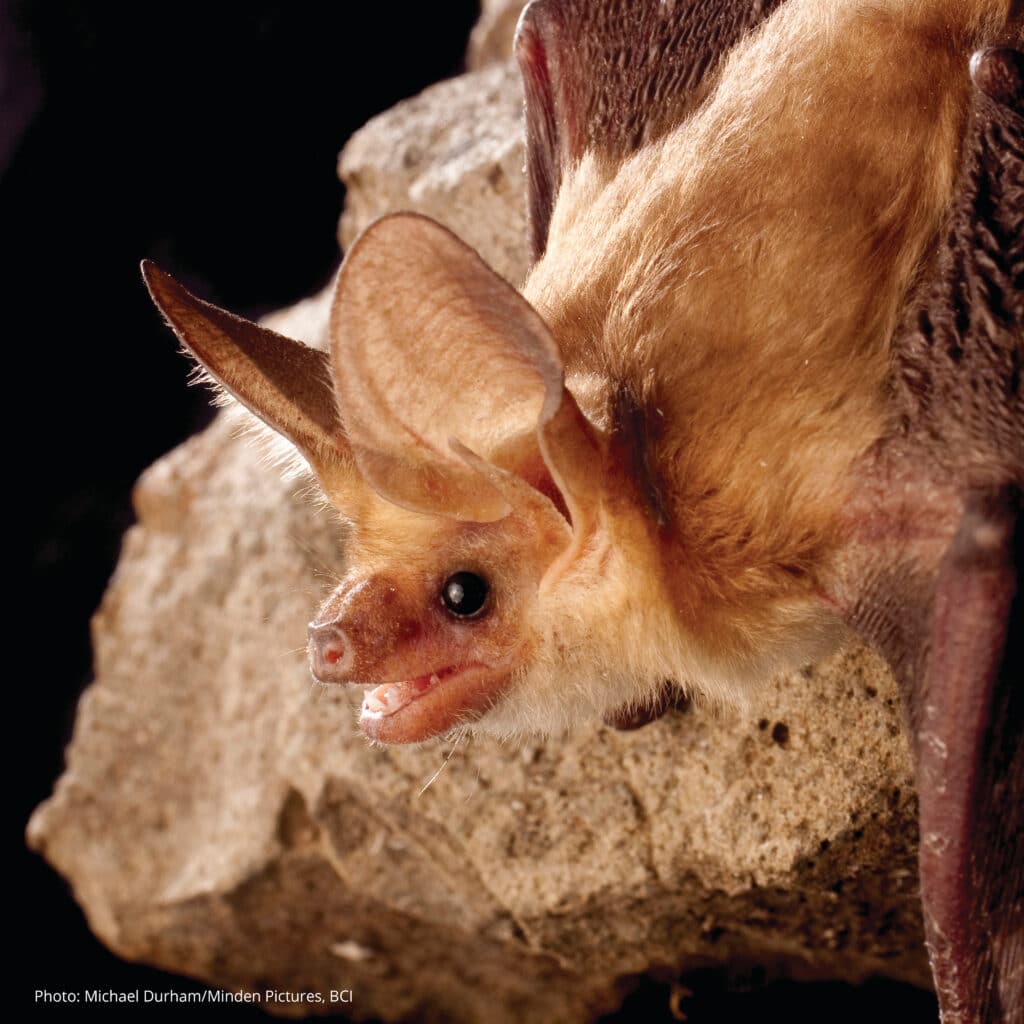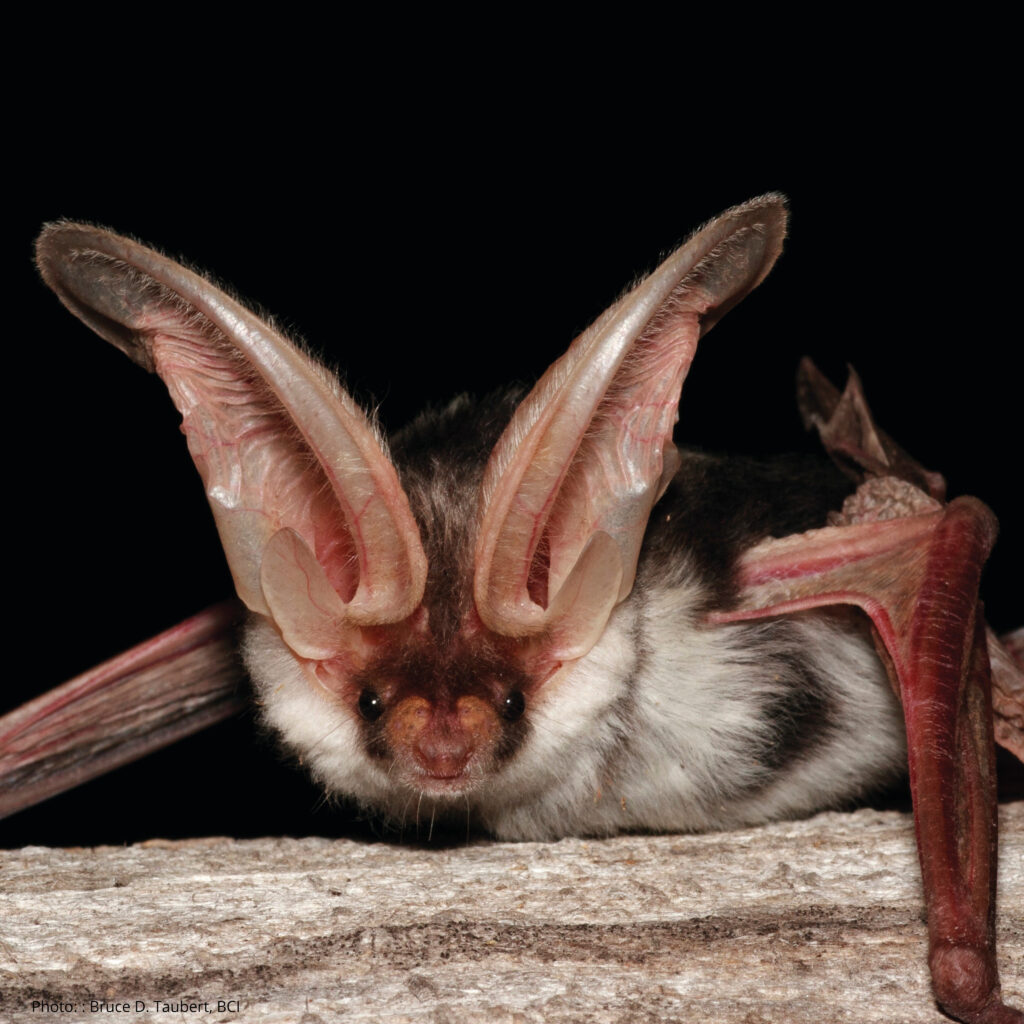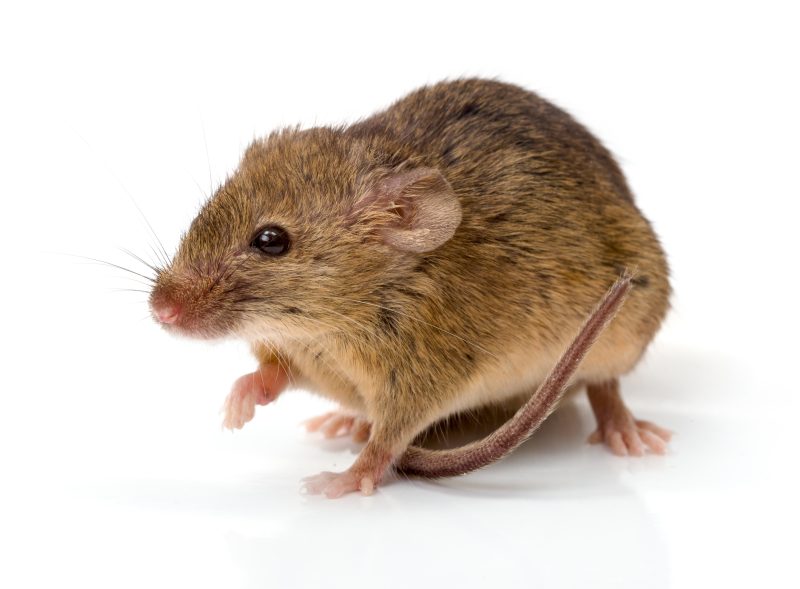Bats are the guardians of our night skies and ecosystems. They swoop above our yards every night, scooping up insects by the hundreds or thousands. About forty-five species inhabit various regions across the U.S., playing a remarkable role in the nation’s biodiversity. Despite their reputation, bats are nonaggressive, gentle animals that provide invaluable ecological services, from pollinating plants and controlling insect populations to dispersing seeds and supporting agricultural productivity. With an estimated population of millions, bats are indispensable allies in maintaining the delicate balance of nature and deserve our understanding and protection. All U.S. bats use echolocation to navigate at night and locate food. Here are several of the most common U.S. species. All are insectivores except one.
Big Brown Bat, Eptesicus fuscus
Found nearly everywhere in the United States, these bats are only 4 to 5 inches (10–13 cm) long and weigh a mere 0.5 to 0.75 ounces (14–21 g)—that’s big for a bat! They hibernate from late fall to spring, preferring caves and mines where the temperature is stable.
They live in diverse environments, from forests and deserts to urban areas. These bats typically roost in buildings, caves, trees, or other structures during the day, often forming colonies ranging from a few individuals to hundreds. They’re opportunistic feeders, preying on a wide variety of insects, including beetles, moths, and mosquitoes, which they catch in flight using echolocation. As temperatures decrease in the late fall, Big Brown Bats enter hibernation, typically from October to April, depending on the region and local climate conditions. During hibernation, they reduce their metabolic rate and rely on stored fat reserves to survive the winter months. They emerge from hibernation around March or April, coinciding with increased insect activity, which will provide them with food.
Little Brown Bat, Myotis lucifugus

A field examination of a Little Brown Bat, Myotis lucifugus (Cameron Eckert / iNaturalist; CC BY-NC 4.0)
The most common bat in the U.S., the Little Brown Bat ranges from Alaska to the southern regions of the country. These bats prefer a variety of habitats, including forests, marshes, and urban areas, where they roost in caves, tree hollows, or buildings during the day. They’re about 2.5 to 4 inches (6–10 cm) long with a wingspan of 8 to 11 inches (20–28 cm). Insectivores, they prey primarily on small flying insects such as moths, beetles, and mosquitoes. As temperatures drop in late fall, Little Brown Bats enter hibernation in caves or other sheltered locations, typically from October to April, depending on the region and local climate conditions. They emerge around March or April when insect activity increases.
Eastern Red Bat, Lasiurus borealis
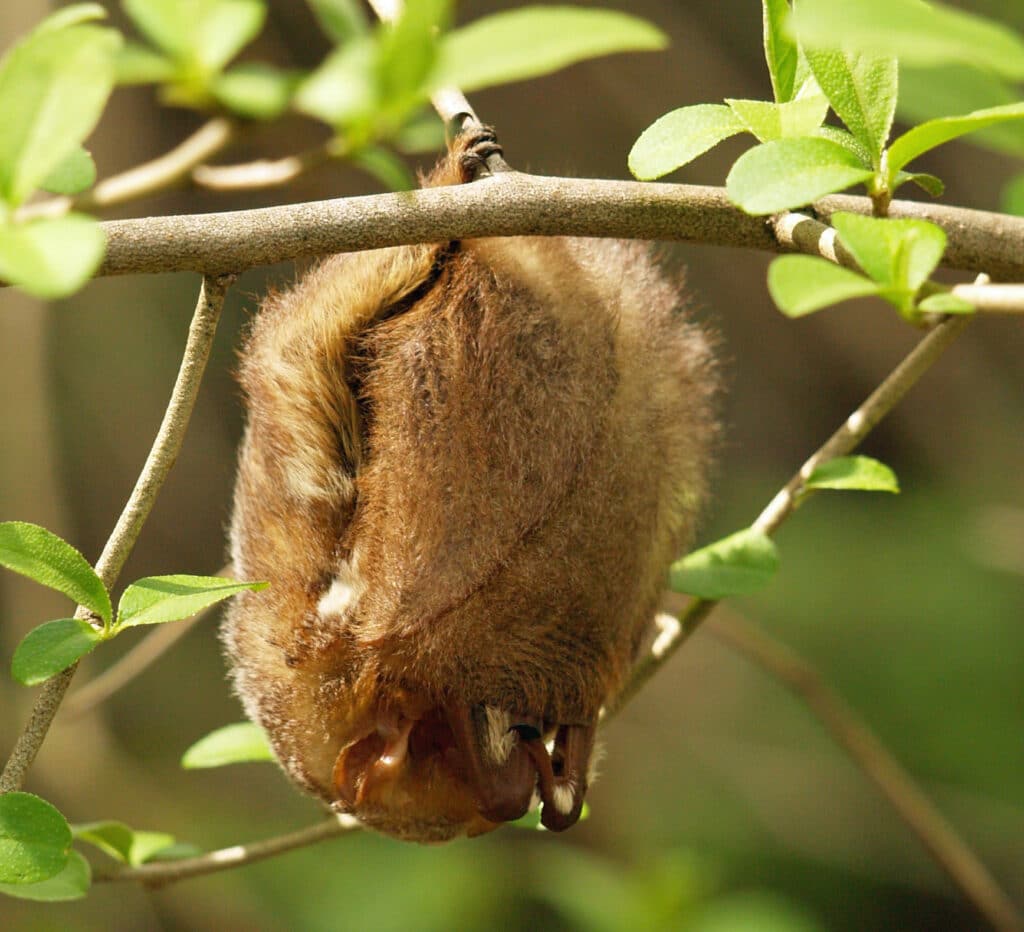
Roosting Eastern Red Bat, Lasiurus borealis, partially wrapped in its furry tail membrane (Chris Henshaw / Wiki; CC BY-SA 4.0)
This bundle of fur is a roosting Eastern Red Bat partially wrapped up in its long, furry tail membrane. These bats are known for their striking reddish fur and membranes, making them easily identifiable. They have a body length of about 3.5 to 5 inches (9–13 cm) and a wingspan of approximately 11 to 13 inches (28–33 cm).
They feed on flying insects, including moths, beetles, and flies. Unlike many other bat species, they don’t roost or hibernate in caves or mines. Instead, they spend summer in trees and also hibernate there in winter, hanging in tree hollows, under loose bark, and on exposed tree trunks. Their fur is long, silky, and warm, and they can use their tail membrane like a blanket, wrapping themselves almost entirely within it. They’ll also use human-made structures like barns or abandoned buildings if suitable natural roosting sites are scarce. Their hibernation sites are selected based on factors such as temperature regulation, humidity levels, and protection from predators. Eastern Red Bats enter hibernation, typically from October to April, and emerge in March or April.
Evening Bat, Nycticeius humeralis
Widely distributed across the U.S., they range from the eastern parts of the country to as far west as eastern Nebraska and south to Texas. They’re small, 3 to 4 inches (7–10 cm) long, with a wingspan of around 10 to 13 inches (25–33 cm). They inhabit forests, woodlands, and urban areas, often roosting in tree cavities, buildings, or bat houses. A colony of 300 Evening Bats can consume 6.3 million insects per summer, principally Spotted Cucumber Beetles, their favorite food. They migrate from the northern parts of their range to southern areas in the winter and may fall into torpor periodically but don’t actually hibernate. Torpor is a state of decreased metabolic activity similar to hibernation but of shorter duration.
Hoary Bat, Lasiurus cinereus
The Hoary Bat is large—up to 5.7 inches (14 cm) long, with a 15-inch (38 cm) wingspan. They’re widespread, living at one time of the year or another throughout the Americas and Galapagos. And they’re the only native mammal in Hawaii. They summer as far north as Canada. In the fall, they migrate to Central and South America, where they often join groups of migrating birds. That must be quite a sight—bats and birds on the wing together!
They’re named for their beautiful white-tipped fur, which looks frosted, or “hoary.” They’re seldom seen, as they usually roost in trees, well-hidden and alone (or a mother with her young—usually two of them). They may travel many miles at night searching for large insects, primarily moths. They mate in early fall, and the following spring, when they migrate to North America, the females will be pregnant.
Lesser Long-nosed Bat, Leptonycteris yerbabuenae
One of only three U.S. bat species that aren’t insectivores, they’re small, only 2.5 to 3.5 inches (6 to 9 cm) long, with a wingspan of about 12 to 14 inches (30–36 cm). Amazingly, their tongue is almost as long as their body! They’re found in the southwestern U.S. and parts of Mexico, inhabiting arid and semi-arid regions such as deserts and scrublands. These bats are crucial pollinators, particularly for plants like agave and cacti, and play a vital role in the ecosystem. They have a specialized diet consisting mainly of nectar and pollen from various desert plants.
Unlike many other bat species, Lesser Long-nosed Bats don’t hibernate. Instead, they undergo seasonal migrations in response to the availability of food. They migrate from central Mexico to the U.S. Southwest in late spring and return to their winter area by September. They’re considered to be vulnerable.
Mexican Free-tailed Bats, Tadarida brasiliensis
The Mexican Free-tailed Bat is widely distributed throughout the U.S., particularly in the southwestern states such as Texas, New Mexico, Arizona, and California. They have a wingspan of approximately 11 to 13 inches (28–33 cm) and a body length of 3.5 to 4.5 inches (9–11 cm). These bats often roost in caves, bridges, and buildings in large colonies. They’re highly adaptable and are known for their impressive aerial acrobatics. They primarily feed on flying insects such as moths, beetles, and flies, which they catch in flight. Mexican Free-tailed Bats do not typically hibernate. Instead, they’re active year-round, although their activity may decrease during cooler months. They may migrate to warmer areas in winter if food sources become scarce.
Pallid Bat, Antrozous Pallidus
This bat is unique because it grabs its prey almost entirely from the ground instead of catching them in flight, as most other bats do. Their body length ranges from 4.5 to 5.5 inches (11–14 cm), with a wingspan of approximately 15 to 16 inches (38–41 cm). They have huge ears and can hear insects by listening to their footsteps! Yeah, they can hear that well!
They feed mostly on beetles, grasshoppers, crickets, and even scorpions (the bats are immune to their sting), consuming up to half their weight every night. They echolocate just above the ground, swoop down, grab their prey, and land on a convenient perch to eat it. This makes them vulnerable to snakes, foxes, coyotes, raccoons, and others. Their habitat is arid and sparsely vegetated grasslands near water, from Mexico north through the Southwest to Oregon, Washington, and western Canada. Pallid Bats have two roosts: a dark daytime one in rocky outcrops, caves, mines, buildings, and hollow trees, and a nearby night roost, which may be less dark, where they rest between feeding forays.
They’re less likely to hibernate than other bats, but if they do, it typically occurs from November to March. In warmer regions, they might remain active year-round.
Spotted Bat, Euderma maculatum
Named for three white spots on their back, you have to wonder why they weren’t named for their huge ears—the largest of any bat in N.A. These bats are about 4.5 inches (11 cm) long, with a wingspan of about 14 inches (36 cm). They live in forests, fields, deserts, marshes, and dry grasslands of Arizona, California, Colorado, Utah, and British Columbia.
Their ears are translucent and nearly as long as their body. They also have pink wings. This bat seems to feed almost exclusively on moths, which it captures high above the ground. Spotted Bats may migrate to warmer regions rather than hibernating. Migration allows them to follow their prey and find suitable roosting sites, often caves or rocky crevices, where they can shelter during the winter.
Virginia Big-eared Bat, Corynorhinus townsendii virginianus

Virginia Big-eared Bat, Corynorhinus townsendii virginianus (Larisa Bishop-Boros / Wiki; CC BY-SA 3.0)
These bats can be identified by their distinctively large ears, measuring approximately 1.5 to 1.8 inches (3.8–4.6 cm), not much shorter than their body, which is 3 to 4 inches (7.6–10.2 cm) long.
This bat inhabits Kentucky, North Carolina, Virginia, and West Virginia, living in caves and mines within forested areas, where they roost during the day in colonies. They’re specialist feeders, primarily consuming moths and beetles, which they catch in flight using echolocation. They hibernate during the winter months, typically from October to April, and emerge from hibernation in the spring when insect activity increases.
So far, Virginia Big-eared Bats have managed to evade white-nose syndrome, a fungus already killing seven other species of bats. That may soon change, as the disease has now been found in caves where these bats hibernate. The fungus is deadly because it disrupts bats while hibernating, causing them to fly away into winter conditions. With no insects to be found, they starve to death. This bat is listed as endangered due to human disturbance.
Yuma Bat, Myotis yumanensis
These bats are relatively small at 2.5 to 3.5 inches (6–9 cm) long and a wingspan of 9 to 11 inches (23–28 cm). Native to the western U.S., particularly in California, Oregon, and Washington, they inhabit forests, deserts, and urban areas, often roosting in tree hollows, caves, or buildings. Yuma bats typically do not enter true hibernation. Instead, they may undergo short periods of torpor during colder weather to conserve energy. Torpor is a state of decreased metabolic activity similar to hibernation but of shorter duration.



